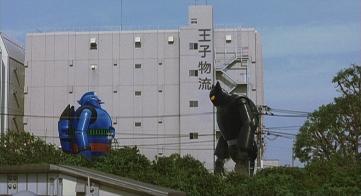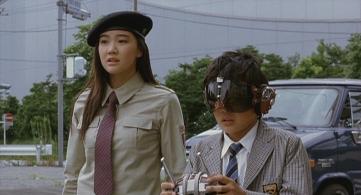|
The
live-action adaptation of the legendary animé series, Tetsujin 28: The Movie, was made to tie in to the
more recent animé (previously
reviewed); it was previewed at the London MCM Expo back
in May, and now comes to DVD courtesy of Manga. Unlike the
series, which seemed to be aimed more towards children than
the usual animé crowd, the movie is a great family
romp that boasts high production values and good acting
talent.
Plotwise,
the movie follows the classic Tetsujin (known as
Gigantor stateside) story: a young boy named Shotaro
(Shosuke Ikematsu) discovers that his father had built a
massive robot for use in Japan's defense forces during the
postwar years, and that – as his father has since passed
away – it is up to him to learn how to control the giant
mecha and lead it into battle against similarly-robotic
enemies that threaten Japan. With the help of his grandfather
Ayabe (Katsuo Nakamura) and teenage technology whizkid Mami
(Yu Aoi), Shotaro discovers a newfound courage within him
and takes on the challenge of beating the Black Ox robot,
created by mad scientist Reiji Takani, as it rampages through
the city.

The
crucial difference for this movie adaptation is that while
the original series was set at the time the series was conceived
(1963), this new production is set in modern-day Tokyo.
I don't think it could've worked well as a period piece;
the script already calls for the viewer to suspend disbelief
that giant robots can be created, and to add an extra layer
of false reality to the film would have damaged it.
Tetsujin
28 is a coming-of-age tale along the lines of Spielberg's
80s classic ET, and the glut of similar films that
followed (Flight of the Navigator, The Last Starfighter
et al). All feature a young boy who has to find the confidence
to stand up and be courageous when he needs to be, and must
learn not to back down in the face of adversity. And, for
the most part, the film fits right into that archetypal
legacy; it's a film that a family can sit down and watch.
Its mature plot points – especially the threat of nuclear
destruction in the closing scenes – are constructed so that
younger viewers will know what's going on without delving
deeply into the realities of the situation.
What
Tetsujin suffers from is a lack of danger. Robots
being robots, they attack slowly and seem to be limited
only to punching eachother – which, when both combatants
are made of metal, doesn't do a whole lot of damage. Later
on in the film, the gimmick of Shotaro "feeling" Black Ox's
hits to Tetsujin as real punches helps to provide a little
empathy, but the combat is still all too stoic. The real
money shots are those that feature the two giants crashing
into and through buildings; the level of realism afforded
to the special effects shots of destruction is excellent,
and you can really believe that a giant robot has just crashed
head-first into Japan's main parliamentary building! Also
of note is the way the robots change from CGI to life-size
props seamlessly; this is especially apparent in the scenes
of Tetsujin's construction.

I
can only praise the character dynamics shown here; the relationship
between Shotaro and his mother is developed upon first in
a humourous exchange over dinner, and then as the movie
goes on, with both mother and child coming to terms with
what Shotaro must do. The development of the villain of
the piece, Reiji, isn't quite as well-done. Despite occasionally
talking of a desire to remake the world in his own image,
Reiji sometimes seems more concerned with vengeance for
the death of his son, and this obfuscation of his aims –
while not especially important to the flow of the movie
– leads to him becoming little more than a cypher; a villain
merely out to cause chaos.
A
small aside here about the language of the movie: the film
is presented in Japanese with subtitles. While I'm used
to watching dubbed animé, I do have some experience
with live-action films, and I have to say that watching
them with subtitles is by far the better way to go. While
in animation, dubbing is often convincing, the few English
dub tracks I've seen on live-action films (Shaolin Soccer
springs to mind) are rather laughable. Thankfully, there
is no English dub here; whether you choose to view this
as a good or bad thing is entirely up to you.
Going
back to the movie, the quality of the CGI used for the robots
is good, but not exceptional. Up close, they clash against
the real-life buildings, appearing noticeably unreal. I
believe the fault lies in the shininess of their
metallic bodies; if the designers had gone for a more weathered,
matte finish to their exteriors, I think it would have seemed
more real. However, I respect that this was probably a conscious
design decision, to keep Tetsujin's overall "look" consistent
between the movie and the animé series. From a distance,
the robots blend into their environments better. I also
noticed some interesting animation effects in the opening
credits and in Shotaro's dream sequence. As for music: The
animé's rousing main theme is used for the opening
credits; the incidental music used for the action and character
sequences is appropriate to the mood of the scenes.
In
conclusion, Tetsujin 28: The Movie would be a great
film to sit down and watch with your family, but only if
all of them can stand to read subtitling over Japanese audio
(or are fluent in Japanese!). The family-friendly quality
of the film is therefore "lost in translation"; it fulfills
this purpose in its native language, but not otherwise.
Nonetheless, while I think it's something that true Tetsujin
fans will either love or hate, I found this movie to be
enjoyable afternoon fare, perfect to keep fans of the genre
occupied.
The
1.85:1 anamorphic transfer looks good, depite being an NTSC
to PAL transfer, which results in some minor blurring on
motion. Certainly the detail levels are pleasing, although
the colour is just a little removed from natural, most noticeable
in the skin tones. Contrast is fine throughout.

Of
the three tracks on offer here, I can't help wondering if
the Japanese stereo 2.0 is probably the most true to the
original mix – the 5.1 and especially the DTS certainly
have kick, with the loud crashes of robot footsteps really
pumping out the bass, but the surrounds are not always used
with precision, the rears sometimes over-active when the
action is taking place up front. All the same, for the clarity,
spread welll mixed lower frequences, the DTS is hard to
resist.
Disappointingly,
there are no extra features on the disc save for a couple
of trailers. However, Manga have included a complicated-looking
model kit of Tetsujin in the packaging; unfortunately, I
hadn't the patience to assemble it myself, but those more
adept with scissors and glue should have a field day.
|